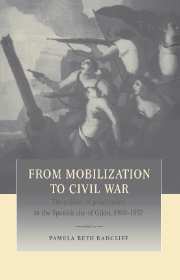Book contents
- Frontmatter
- Contents
- List of maps
- List of tables
- Acknowledgments
- Glossary of terms and abbreviations
- Introduction
- 1 A turning point: the city in 1900
- PART I Patterns of life in working-class Gijón
- PART II Institutional forces of opposition: republicans and anarchosyndicalists
- PART III Defining an oppositional culture: the struggle over the public sphere
- PART IV The urban battlefield: conflict and collective action, 1901–1936
- Conclusion
- Appendix 1 Wage and price movement
- Appendix 2 Occupations by status category
- Appendix 3 Supplementary tables
- Select bibliography
- Index
Appendix 1 - Wage and price movement
Published online by Cambridge University Press: 31 October 2009
- Frontmatter
- Contents
- List of maps
- List of tables
- Acknowledgments
- Glossary of terms and abbreviations
- Introduction
- 1 A turning point: the city in 1900
- PART I Patterns of life in working-class Gijón
- PART II Institutional forces of opposition: republicans and anarchosyndicalists
- PART III Defining an oppositional culture: the struggle over the public sphere
- PART IV The urban battlefield: conflict and collective action, 1901–1936
- Conclusion
- Appendix 1 Wage and price movement
- Appendix 2 Occupations by status category
- Appendix 3 Supplementary tables
- Select bibliography
- Index
Summary
WAGES
Wages for typical occupations in Asturias and Gijón during the period covered by the book are listed in Tables 1.1 and 1.2. To gauge the rise in wages between 1914 and 1930, 1 calculated an estimate of the mean for each range. I assumed that the spread of maximum and minimum wages was a greater reflection of the spread between masters and journeymen than that between masters in different workshops. Following this assumption, I decided to set the mean at one-third above the minimum wage, since there should be fewer masters than journeymen. That is, if we could plot the curve of all painters' wages, it would probably be weighted toward the lower wage. With the mean wage for each category I set the index at the 1914 means and calculated the relative increase in wages (Table 1.3). Although this index provides a general picture of wage movement, it is still limited. It does not tell us how people at the bottom or top of each profession fared, a distinction which appeared increasingly important after 1919. That is, the trend over the 1920s seems to be towards a greater spread within professions. While top wages rose consistently, the minimum wages moved more unevenly, even dropping in 1930 in the construction industry. So, although the table can yield general information about wages, it cannot give us insight into any individual worker's fate.
PRICES
Serial price movements are available on a yearly basis from 1909 in the Anuario Estadístico de Espana. However, it is more difficult to determine their applicability to Gijón.
- Type
- Chapter
- Information
- From Mobilization to Civil WarThe Politics of Polarization in the Spanish City of Gijón, 1900–1937, pp. 315 - 321Publisher: Cambridge University PressPrint publication year: 1997



